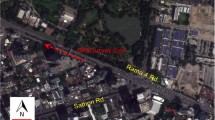Abstract
Efficient restoration of deteriorating coastal structures requires an accurate picture of both above ground and underground features. Although ground penetrating radar (GPR) can map underground features, it creates reflection artifacts. Here, a model for deconvolution calibration was developed in an outdoor small-scale experiment. GPR parameters were established, then applied at a deteriorating fishing port in northeast Taiwan. The deconvolution filter removed repetitive reflection patterns under the lowest part of the void creating a more accurate map. A 3D-map was created from interpolated sketched void boundaries. Due to its high lossy nature at radar frequencies and large contrasting relative dielectric permittivity (RDP) to the upper medium, the seawater table (SWT) is easily identified. The upper boundary of reflection-free area in the deconvoluted radargram, therefore, indicates the SWT. The methods developed here are easily modified to fit a wide range of situations.














Similar content being viewed by others
References
Benson AK (1995) Applications of ground penetrating radar in assessing some geological hazards: examples of groundwater contamination, faults, cavities. J Appl Geophys 33:177–193
Beres M, Luetscher M, Olivier R (2001) Integration of ground-penetrating radar and microgravimetric methods to map shallow caves. J Appl Geophys 46:249–262
Chamberlain AT (2000) Cave detection in limestone using ground penetrating radar. J Archaeol Sci 27:957–964
Cheng DK (1989) Field and wave electromagnetics. Addison-Wesley, New York
Conyers LB, Goodman D (1997) Ground-penetrating radar: an introduction for archaeologists. AltaMira, Walnut Creek
Daniels DJ (2004) Ground penetrating radar. 2nd edn. The Institution of Electrical Engineers, London
Daniels JJ, Roberts R, Vendl M (1995) Ground penetrating radar for the detection of liquid contamination. J Appl Geophys 33:195–207
Davis JL, Annan AP (1989) Ground-penetrating radar for high-resolution mapping of soil and rock stratigraphy. Geophys Prospect 37:531–551
Doolittle JA, Jenkinson BJ, Franzmeier DP, Lynn W (2000) Improved radar interpretations of water table depths and groundwater flow patterns using predictive equations. Eighth International Conference on Ground-penetrating radar, The University of Queensland, Goldcoast, pp 488–495
Du HI (2000) The application of ground-penetrating radar in a serpentine quarry. Master thesis, National Central University (in Chinese)
Geophysical Survey System Inc. (GSSI) (2003) Radan for windows (version 5.0, user’s manual). GSSI, North Salem
Goodman D (1994) Ground-penetrating radar simulation in engineering and archaeology. Geophysics 59:224–232
Grandjean G, Gourry JC (1996) GPR data processing for 3D-fracture mapping in a marble quarry (Thassos, Greece). J Appl Geophys 36:19–30
Grasmueck M (1996) 3D ground-penetrating radar applied to fracture imaging in gneiss. Geophysics 61:1050–1064
Inan US, Inan AS (2000) Electromagnetic waves. Prentice Hall, Upper Saddle River
Jol HM (1995) Ground penetrating radar antennae frequencies and transmitter powers comparedfor penetration depth, resolution and reflection continuity. Geophys Prospect 43:693–709
Kuo CW (2005) Taiwan professional civil engineers association. Expertise report, Banciao (in Chinese)
Lin MH (2000) Application of ground penetrating radar in void analysis. Master thesis, National Cheng Kung University, Tainan (in Chinese)
Malagodi S, Orlando L, Piro S, Rosso F (1996) Location of archaeological structures using GPR method: three-dimensional data acquisition and radar signal processing. Archaeol Prospect 3:13–23
Nakashima Y, Zhou H, Sato M (2001) Estimation of groundwater level by GPR in an area with multiple ambiguous reflections. J Appl Geophys 47:241–249
Neves FA, Miller JA, Roulston MS (1996) Source signature deconvolution of ground penetrating radar data. Proceedings of sixth international conference on ground penetrating radar, Sendai, pp 573–578
Porsani JL, Sauck WA, Júnior AOS (2006) GPR for mapping fractures and as a guide for the extraction of ornamental granite from a quarry: a case study from southern Brazil. J Appl Geophys 58:177–187
Rees HV, Glover JM (1992) Digital enhancement of ground probing radar data. In: Pilon JA (ed) Ground penetrating radar, Geological Survey of Canada paper 90-4:187–192
Silva CCN, Medeiros WE, Sa EFJ, Neto PX (2004) Resistivity and ground-penetrating radar images of fractures in a crystalline aquifer: a case study in Caiçara farm—NE Brazil. J Appl Geophys 56:295–307
Stevens KM, Lodha GS, Holloway AL, Soonawala NM (1995) The application of ground penetrating radar for mapping fractures in plutonic rocks within the Whiteshell Research Area, Pinawa, Manitoba, Canada. J Appl Geophys 33:125–141
Ulriksen CPF (1995) Application of impulse radar to civil engineering. Lund, Sweden
Xia JH, Franseen EK, Miller RD (2003) Improving ground-penetrating radar in sedimentary rocks using deterministic deconvolution. J Appl Geophys 54:15–33
Yilmaz Ö (1987) Seismic data processing. Society of Exploration Geophysicists, Tulsa
Acknowledgments
The authors are indebted to the National Science Council for the support of this research (project number: NSC 93-2119-M-019-001). Thanks are also due to Mr. J. G. Sie and C.W. Kuo for the assistance of site data collection and Mr. S. K. Chang for the software instruction.
Author information
Authors and Affiliations
Corresponding author
Rights and permissions
About this article
Cite this article
Chen, YL., Chow, J.J. Ground penetrating radar signal processing improves mapping accuracy of underground voids and seawater table: an application in deteriorating coastal structure, Nanfangao Port, Taiwan. Environ Geol 53, 445–455 (2007). https://doi.org/10.1007/s00254-007-0660-7
Received:
Accepted:
Published:
Issue Date:
DOI: https://doi.org/10.1007/s00254-007-0660-7




